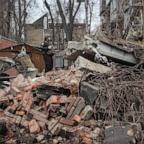Nearly 40% of the world's trees face extinction, according to new assessment
Climate change, deforestation, invasive pests and disease all threaten to permanently wipe out nearly 40% of the earth's trees, according to a new assessment by the International Union for the Conservation of Nature (IUCN).
The organization, comprised of 1,400 member organizations worldwide and 16,000 experts, said more than one in three tree species across 192 countries is now facing extinction, especially trees found on islands.

The IUCN said island trees are at particular risk because of deforestation for new development and agriculture, as well as the other threats faced by tree species across the globe.
Since 1964, the IUCN has hosted its "Red List," a database of threatened species from around the world. The research group found that 16,425 of the 47,282 tree species on their list are at risk of extinction -- more than 2,000 of which are used for medicines, food, and fuels.
"Trees are essential to support life on Earth through their vital role in ecosystems, and millions of people depend upon them for their lives and livelihoods," said Grethel Aguilar, IUCN director general, in a statement.
According to their analysis, "the number of threatened trees is more than double the number of all threatened birds, mammals, reptiles and amphibians combined."
The group is calling for more habitat protection and restoration to protect these species and the creation of seed banks and botanical gardens to ensure they don't disappear forever.
“The significance of the Global Tree Assessment cannot be overstated, given the importance of trees to ecosystems and people. We hope this frightening statistic of one in three trees facing extinction will incentivize urgent action and be used to inform conservation plans,” said Eimear Nic Lughadha from the Royal Botanic Gardens, in a statement.
-ABC News Climate Unit's Matthew Glasser







